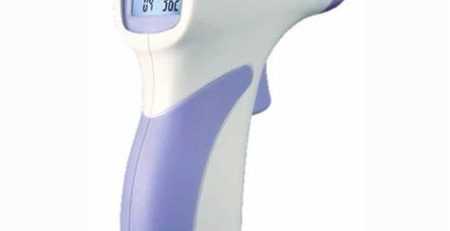
21
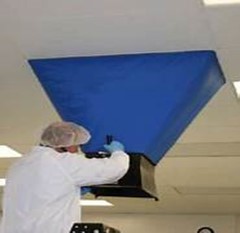
Phi Sigma India is a recognized leader in cleanroom validation, calibration, and certification, performed by highly proficient technical staff. Our testing complies with relevant standards, including ISO 14644-2, 3, 4; EU GMP/EC GMP; FS 209E; WHO 2002; USFDA; MHRA; and the Drug and Cosmetic Act of India 2005. We offer cost-effective, timely execution of work and hassle-free management to handle bulk orders. Annual maintenance is also provided.
We offer the following validation services:
- Air Velocity (Flow) Test & ACPH Calculation
- HEPA Filter Integrity Test
- Particle Count Test
- Recovery Test
- Pressure Balancing Test
- Air Flow Pattern Test
- Temperature & RH Measurement
- Light Intensity Measurement
- Sound Level Measurement
Phi Sigma India is a recognized leader in cleanroom validation, calibration, and certification, performed by highly proficient technical staff. Our testing complies with relevant standards, including ISO 14644-2, 3, 4; EU GMP/EC GMP; FS 209E; WHO 2002; USFDA; MHRA; and the Drug and Cosmetic Act of India 2005. We offer cost-effective, timely execution of work and hassle-free management to handle bulk orders. Annual maintenance is also provided.
We offer the following validation services:
- Air Velocity (Flow) Test & ACPH Calculation
- HEPA Filter Integrity Test
- Particle Count Test
- Recovery Test
- Pressure Balancing Test
- Air Flow Pattern Test
- Temperature & RH Measurement
- Light Intensity Measurement
- Sound Level Measurement
Air Velocity Test

Air velocity measurement determines the uniformity of the filter face velocity and the total room airflow volume within a cleanroom. We use Accubalance Air Capture Hoods to ensure accurate test results, measuring air volume flowing through registers, diffusers, and grills. The hoods are held up to a diffuser or grill, and the supply or exhaust airflow is read directly on a large digital display.
HEPA Filter Integrity Test (Using POA)

We provide comprehensive HEPA/ULPA filter integrity testing services for both the pharmaceutical and microelectronics industries. The HEPA filter integrity test, known as the PAO test, uses PAO as the aerosol reagent to challenge the filter. We use calibrated aerosol photometers and aerosol generators for this test.
Particle Count Test
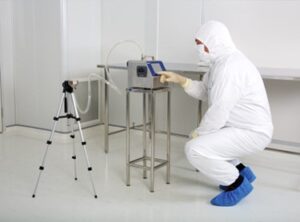
This critical test for cleanroom validation is performed using a TSI Particle Counter. Our particle count test provides a complete airborne particle count cleanliness classification of cleanrooms, laminar airflow units, bio-safety cabinets, isolators, fluid bed dryers (FBD), fluid bed equipment (FBE), autoclaves, dry heat sterilizers, air showers, coaters, garment cubicles, vial sterilization tunnels, and more. It determines the actual particle count level within the facility at the time of the test.
Recovery Test
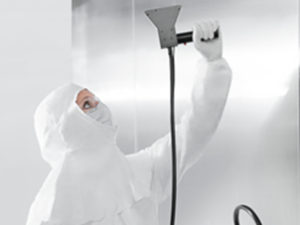
The recovery test establishes how long it takes for the cleanroom to recover from a challenge concentration to the target cleanliness level. This test demonstrates the cleanroom’s ability to remove particulate matter by purging the area with filtered air, ensuring it can change from a “dirty” to “clean” state within the specified time.
Pressure Balancing Test

The air pressure difference test verifies the cleanroom system’s ability to maintain the specified pressure differential between the installation and its surroundings. This test is performed after meeting the acceptance criteria for airflow velocity, volume airflow uniformity, and other applicable tests.
Air Flow Pattern Test (Using Water Fogger)
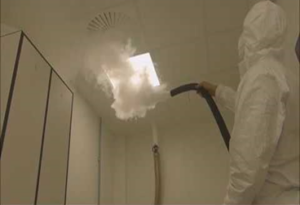
The airflow visualization test shows the actual airflow pattern throughout the unidirectional cleanroom. It is best performed after all airflow velocity and uniformity tests and room pressurization tests. We use a distilled water/WFI-based cleanroom fogger, ensuring no residues are spread during testing. The sterile nature of WFI reduces the risk of any chemical contamination in the cleanroom.
Temperature & RH Measurement
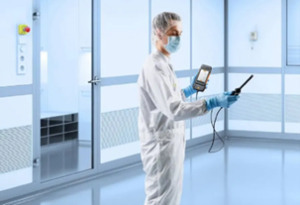
We conduct validation tests that include temperature and humidity measurements. Two levels of temperature and humidity tests are used depending on the requirement. The first level tests general temperature and humidity uniformity to ensure the cleanroom’s HVAC system maintains the specified levels required for occupant comfort. The second level, or comprehensive level test, ensures that the HVAC systems maintain the specified levels required for both occupant comfort and process temperature control.
Light Intensity Measurement
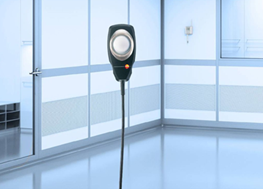
The lighting level tests verify that the installed light levels and uniformity meet the specified requirements. We use modern testing instruments to assess lighting lux levels and intensity.
Sound Level Measurement
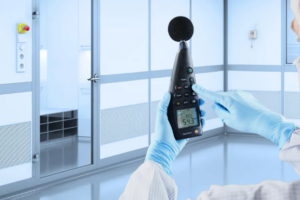
We perform noise level tests that measure sound pressure. The measurements vary based on the occupancy state of the cleanroom, but the testing procedures remain identical.







